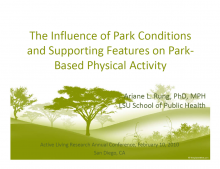We are pleased to announce an exciting new alliance between Active Living Research and GP RED to co-host and coordinate...
The Influence of Park Conditions and Supporting Features on Park-Based Physical Activity

Presentation at the 2010 Active Living Research Annual Conference
Background:
Recent studies suggest that park features contribute to park visitation and park-based physical activity (PBPA). The condition of parks may also contribute to visitation and PBPA. However, few studies have collectively examined the role of park features and their condition in shaping park visitation levels and PBPA. For planners to have a compelling reason to change park design policies or maintenance practices, there is a need to document whether park activity areas (e.g., ball fields, paths, playgrounds), support features (e.g., restrooms, fountains, benches), and their condition contribute to park use and PBPA.
Objectives:
To determine how park features and their condition relate to park visitation and PBPA.
Methods:
Thirty-eight New Orleans parks that included at least one activity area of interest were observed in 2007. PBPA was assessed using SOPARC, whereby the number of persons engaged in sedentary, walking, or vigorous physical activity in each target area was recorded every half-hour between 4 and 7 PM for 2-4 weekdays. Three aggregate outcomes were calculated according to established formulas: total number of park users, mean energy expenditure (EE) rate per person (kcal/kg/min), and total estimated EE (kcal/kg) for the entire target area across 3 hours. Park features and their condition were assessed simultaneously with the BRAT-DO park audit tool. 113 target areas within the 38 parks represented our unit of analysis. Multilevel (mixed model) analyses were used to analyze the relationships between activity area characteristics and outcomes.
Results:
On average, 8.1 park users were observed in a given activity area over the 3-hour observation period, with an average EE/person of 0.081 kcal/kg/min, and an average of 15.1 kcal/kg of total EE/target area was expended over the three hour period. The number of park users (p=0.0122) and mean EE/person (p=0.0004) varied significantly across types of activity areas (Table). Basketball courts had a higher number of users and higher mean energy expenditure per person than other types of park areas. Total 3-hour EE/target area also was marginally associated with the type of activity area (p=0.0540).
The number of park users, mean EE/person, and total EE/target area were further related to the presence of certain supporting features and the condition of specific activity areas. Target areas with restrooms and drinking fountains had more users and higher EE/target area than areas without these support features. There were no significant relationships between the condition of park features and mean EE/person. However, for basketball courts, being in good condition was positively related to the number of park users and the total 3-hour EE/target area.
Conclusions:
Our findings are consistent with prior research in that the type of park activity area (particularly basketball courts and sport fields) contributed to park use and per person park energy expenditures. We also found that the presence of any park supporting feature within a target area (specifically, the presence of restrooms and drinking fountains) corresponded with higher visitor counts and total EE/target area. These results suggest that certain sport-oriented activity areas, restrooms, and drinking fountains may contribute to increased visitation and physical activity levels and could be considered in neighborhood park rehabilitation projects that are designed to promote park use and physical activity. Finally, we did not find significant relationships between the overall condition of park activity areas with mean EE/person. However, the condition of basketball courts was positively related to the number of park users and total EE/target area. Park planners who wish to maximize park visitation levels and physical activity at parks or specific park areas should consider the role that restrooms and drinking fountains have in facilitating these outcomes. Where appropriate, basketball courts and sport fields could also be considered as options for increasing both visitation levels and per person physical activity levels.
Support:
This research was supported by Cooperative Agreement Number 5K01DP000088 from the CDC.
STAY UP TO DATE
RECENTLY ADDED TOOLS & RESOURCES
MOVE! A BLOG ABOUT ACTIVE LIVING
The "Active Living Conference" aims to break down research and practice silos and...







